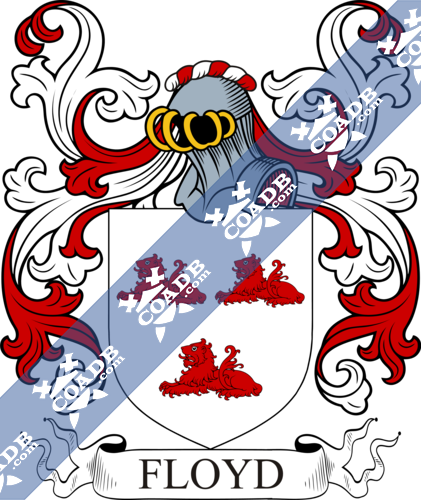Floyd Family Crest, Coat of Arms and Name History

Floyd Coat of Arms Gallery
Don’t know which Coat of Arms is yours?
We can do a genealogical research. Find out the exact history of your family!
Learn MoreSurname Name Meaning, Origin, and Etymology
The Flood name was originally Fludd or Floyd. The English name Floyd is the same as the Welsh Llwyd (or clwyd), meaning brown, gray, hoary or the Welsh Lloyd and Lhuyd, meaning gray or brown. The Irish surname Floyd was originally from the Gaelic McTuile, O Maoltuile, or Mac Maoltuile. Tuile meant ‘flood’ and in Ireland, Tully and Flood were interchangeable. The surname Lloyd has its home in North and South Wales; but it is frequently found in Shropshire, Hereford, and Monmouth, England.
Spelling Variations
Common spelling variations of this last name include: Floyd, Floyde, Flude, Flood, Floode, Lloyd, Llwyd, Lloid, Loyd, Loid, Lwyd, Tully, MacTully, Talley, and Tally
Early Bearers of the Surname
From Andrew Borde’s Book of Knowledge, the early holders of the name include: Thomas Lloyd or Floyd (1510); Thomas Lloide or Floide (1569), David Lloyde or Floyd (1570). The first recorded spelling of the name “Lloyd” is “Richard Loyt”, in the Worcestershire Subsidy Rolls of 1327, during the time of Edward III; and Ithell Lloit, who appears in the records of Chirk, Wales, in 1391, The first recorded spelling of the Floyd name is Richard Floyd, dated 1509, during the reign of King Henry VIII.
Jenkin Lloyde of Montgomeryshire, and Griffith Lloid of Radnor were registered as students at Oxford University during the period 1577 – 1585. Edward Lloyd, who flourished circa 1692, kept a coffee-house in Lombard Street, city of London, and it is from him that the great commercial corporation known as “Lloyd’s” derives its name. His premises was the center of shipbroking and the marine insurance business in the late sixteen hundreds. (Not the company of Lloyd’s of London).
History, Genealogy, and Ancestry
Lloyd of Bronwydd is the 23rd Baron of Kemes, co. Pembroke, descending from Martin de Tours, a friend of William the Conqueror.
Lloyd of Plymog comes from the Marchudd ap Cynan in the 9th century. Lloyd of Aston comes from the royal house of Powys. Llyd of Dan-yr-allt comes from Cadivor ap Dyfnwall, lord of castle Howel, and lineally sprung from Rhodri Mawr, King of Wales. Lloyd of Coedmore comes from an ancient Prince of Ferlys. Lloyd of Clockfaen comes from the Tudor Trevor in the 10th century. Lloyd of Pale comes from Held Molwyrogg, a chieftain of Denbighland .
The Floyd family of is of ancient Welsh descent and sometimes resided at Beeston Castle which was destroyed in 1645. The family descends from Captain John Floyd of the 1st Dragoon Guards, of Prestbury, Cheshire, and St. Chadds, Shrewsbury. He was born in 1707. On October 28, 1746, he married Mary, daughter of Rev. Richard Bate of Chilham, Kent (born 1713 and died November 8, 1782). Their children were John, who became the first baronet; Thomas, a Lieutenant in the Royal Navy, who died on board HMS Conqueror off Sandy Hook in October 16, 1778, unmarried; Elisabeth Powys, born 1752 and died unmarried April 11, 1830; and Caroline, who married John Christopher Ridout, of Baughurst House, Hants. He died October 21, 1817 and she died March 7, 1821. Captain Floyd served in the Seven Year War. He fought in the battle of Minden and died of wounds received September 12, 1759 serving in Germany.
His oldest son, General Sir John Floyd, was the 1st Baronet. He began his military career at the age of 12, when he was appointed cornet in Eliot’s light horse (16th hussars) during 1760, due to his father’s influence. He eventually attained the rank of General and was granted a baronetcy on March 30, 1816. Sir John married his first wife, Rebecca Juliana, daughter of Charles Darke (an eminent merchant of Madras) January 9, 1791. They had children: Henry (2nd Baronet), Miranda, Julia, Flavia. She died February 3, 1802. He married his second wife, Anna, the widow of Sir Harry Denny, Baronet of Tralee Castle, and daughter of Crosbie Morgell, of Mount Morgell, county Limerick, on July 29, 1805. Sir John was born February 22, 1748 and died January 10, 1818. Lady Floyd died November 4, 1844.
Sir John was survived by his only son, Sir Henry Floyd, the 2nd baronet. Born September 2, 1793, he married Mary, eldest daughter and co-heir of William Murray, of Latium, Jamaica, and Bryanston Square, London, August 30, 1821. Their children were: John (3rd Baronet), William Murray, and Robert Peel. Sir John’s wife died October 27, 1870.
Early American and New World Settlers
Melchesedick Floyd arrived in Virginia in 1638. James John Floyd (1750 – 1783), known as John Floyd, was a pioneer around Louisville, Kentucky where he worked as a surveyor for land development and helped lay out Louisville. He served as a Colonel of the Kentucky Militia and participated in raids with George Rogers Clark.
Mottoes
The family mottoes include: Patienspulrerls atque soils
Flood – Vis unita fortior – Strength united is the more powerful
Floyd – Patiens pulveris atque solis – Patient of dust and sun (Sir John Floyd)
Lloyd – A vino duw derwd – When God willeth He will come
Lloyd – Auxilium meum a Domino – My help is from the Lord
Lloyd – Ddal gwaed Cymru – Entertain Welsh blood
Lloyd – Dial gwaed Cumru – Welsh blood will revenge
Lloyd – Eo altius quo profundius – The higher the deeper
Lloyd – Esto vigilans – Be vigilant
Lloyd – Fide et fortitudine – With faith and fortitude
Lloyd – Gwell angau na cywilydd – Better death than shame
Lloyd – Heb Dduw heb ddim, Duw a digon – Without God without anything, God is enough
Lloyd – Hwy peri clod na golud – Fame lasts longer than riches
Lloyd – I Dduw bo’r diolch – To God be thanks
Lloyd – Jure, non dono – By right, not by gift
Lloyd – Nec timet, nec tumet – He is neither timid nor arrogant
Lloyd – Respice prospice – Look backward and forward
Lloyd – Resistite usque famœ – Keeping in the footsteps of good report
Lloyd – Retineus vestigia famœ – Still treading in the footsteps of an honourable ancestry
Lloyd – Seetabuldee – Seetabuldee
Lloyd – Spectemur agendo – Let us be viewed by our actions
Lloyd – Touts jours prest – Always ready
Lloyd
Arms—First, Argent, three lions dormant, in pale sable. Second, Or, three mens’ heads proper in armor argent garnished of the field.
Crests—First, ademi-arm in scale armor, the hand naked proper, the cuff argent, grasping a lizard vert. Second, two arms embowed, armed proper, supporting a chaplet of oak branches vert, fructed or. Third, a man’s head proper in armor argent garnished or, and on a labe issuing from his mouth, and proceeding over his head, these words, Avonno div derbid
Flood:
Arms—Vert, a chevron between three wolves’ heads erased argent, belonging to Sir Thomas Fludd, of the county of Kent during the 1500’s. Crest—A wolf’s head, as in the arms.
Sir John Floyd (1748 – 1818) pursued a brilliant military career in India, distinguishing himself particularly in the wars against Tippoo Sultan; he was created general in 1812, and baronet in 1816. His Coat of Arms is a black shield charged with a silver lion rampant (standing on his hind legs) regaurdant; on a gold chief embattled is a sword erect proper, pommel and hilt gold, enfiled with a red eastern crown between two tigers’ faces also proper. A silver lion rampant regaurdant, crowned gulles (red), bearing a flag representing the standard of Tippoo Sultan, flowing to the sinister proper, is on the Crest.
Notables
Famous people with this last name include: 1) William Floyd (1734 – 1821) who was one of the signatories of the American Declaration of independence 2) Charles Arthur Floyd, known as Pretty Boy Floyd, who was an American bank robber, shot by police while attempting to evade being recaptured, after having escaped prison 3) Andrew Lloyd Webber (Baron Lloyd-Webber) born in 1948, was an English composer 4) Christopher Lloyd, born in 1938, is an American character actor best known for his roles as Emmet ‘Doc’ Brown in the Back to the Future series, and Uncle Fester, in the Addams Family and its sequel 5) Sampson Lloyd, co-creator of Lloyds Bank in England, considered to be one of the ‘Big Four’ clearing banks-not to be confused with Lloyd’s of London 6) Charles Floyd (1782-1804), American explorer, quartermaster on the Lewis and Clark Expedition
Blazons & Genealogy Notes
1) (bart.). Sa. a lion ramp. reguard. ar. on a chief embattled or, a sword erect ppr. pommel and hilt gold, enfiled with an Eastern crown gu. betw. two tigers’ faces also ppr. Crest—A lion ramp. reguard. ar. murally crowned gu. bearing a flag representing the standard of Tippoo Sultan flowing to the sinister ppr. Motto—Patiens pulveris atque solis.
2) (co. Brecknock). Ar. a griffin segreant az.
3) Ar. a cross sa. Crest—A griffin sejant az. holding in the dexter paw a garland of laurel vert.
4) (Ireland; descended out of Wales; impalement Fun. Ent. 1675, Doctor Cardiff, buried in Christ’s Church, Dublin). Ar. three lioncels couchant gu.
5) (Reg. Ulster’s Office). Vert a chev. betw. three wolves’ heads erased ar. a crescent for diff.











